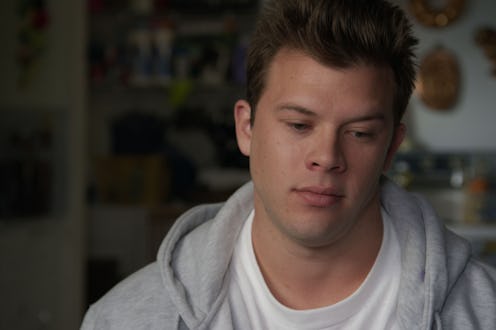
Netflix's American Vandal is a parody of the highest order: An elaborate d*ck joke seemingly better suited for an SNL sketch somehow stretched into a season's worth of riveting TV. In fact, the true crime spoof is so well-executed that after a few episodes, you find yourself genuinely invested in its asinine whodunnit: Did Dylan draw the graffiti on American Vandal, or is he a mere red herring? Spoilers ahead for American Vandal Season 1.
It's a bittersweet mystery, because Dylan is not exactly the easiest person to root for. He's juvenile, moronic, and quite frankly, a flat-out jack*ss, but given how quickly people are willing to blame him without question, he's also a bit of an underdog — a fact that makes him marginally more sympathetic, and the premise exponentially more interesting. For high school documentarian Peter Maldonado, tracking down who "did the d*cks," as the show calls it, isn't so much about helping Dylan as it is seeking justice, but the truth of the matter is that, no, Dylan did not draw the graffiti. So who did?
For those still making sense of the investigation (or just really fond of spoilers), let's back up. American Vandal centers around a sophomoric prank in which an unknown offender defaces 27 cars in the faculty parking lot with spray-painted penises, causing upwards of $100,000 in damages. As Hanover High's resident burnout, Dylan quickly emerges as the lead suspect. His alibi is weak, his motives are strong, and a witness puts him at the scene of the crime. Add that to his reputation for emblazoning male genitalia across classroom whiteboards, and that's all it takes to get him slapped with an expulsion. He insists that he's innocent, but the evidence against him is too damning to outweigh his reputation; his fate is sealed.
The community seems unfazed by this chain of events — everyone, that is, except for Peter, an AV geek with a thirst for truth. He sets out to get to the bottom of it while filming the process, giving way to a spot-on true crime satire complete with grainy depositions, gratuitous scenery shots, elaborate evidence boards, and a dozen case-changing cliffhangers — one of which proves enough to exonerate Dylan. When Dylan stopped by his girlfriend's house at the time the graffiti occurred, she happened to be in the midst of video chat that caught him on tape, placing him there during the crime, not at the high school. Peter manages to obtain a copy of the footage and shows it to the school board, and Dylan is reinstated at Hanover; The real vandal remains at large.
But then, star student Christa Carlyle inadvertently slips up on her alibi. When a drunk student needs CPR at an after-prom party, she calls for help, suggesting she never actually received the CPR training she claimed to be getting during the graffiti incident. Peter then discovers that the instructor listed on her certification is Van Delorey, Christa's boyfriend, and theorizes that they acted as accomplices. Christa was upset by the school's inaction when she filed a complaint against Coach Rafferty earlier that year. When she tried out for the football team, he forced her to partake in an aggressive hitting drill — an unnecessary step, given that she was trying out for kicker — and then yelled something at Christa that made her visibly uncomfortable. Her resulting complaint went untouched for six months, and Rafferty was never reprimanded. After analyzing the splatter of the penises, Peter's documentary had narrowed the list of initial targets down to three people — Rafferty being one of them. Also of note? Christa was one of Dylan's staunchest supporters: She even handed out "Free Dylan" T-shirts and started a campaign on Go Fund Me. Guilty conscience perhaps? But, when Peter finally sits down with Christa to discuss his suspicions, she denies any involvement.
Despite the overwhelming amount of evidence, Peter is hesitant to say Christa did it, because he's "seen the way an accusation can ruin someone's life." And instead, he leaves things unresolved. The catch? Dylan capitalizes on his newfound innocence by vandalizing his Spanish teacher's home, alleging he was once again framed. Except this time, her neighbor's security camera caught him red-handed.
There isn't really a moral to the story, but it's an entertaining ride, and ironic as it is, it shows that not even an over-the-top d*ck joke can derail the true crime obsession still raging on.